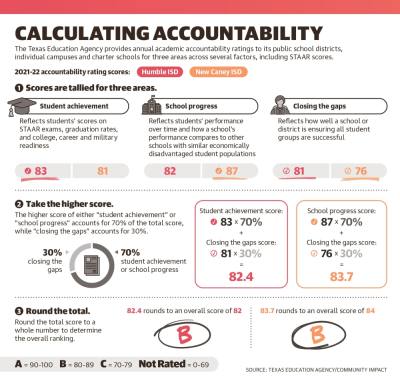Texas legislators passed House Bill 3906 in May 2019, transitioning the State of Texas Assessments of Academic Readiness, or STAAR exam, from a mostly pencil-and-paper test to an online exam. The redesigned test also features more question varieties and changes to written essay prompts, and requires student knowledge of subjects outside of the one being tested, according to the Texas Education Agency’s website.
“Feedback from educators informed the main components of the STAAR redesign, and both educators and students provided input to ensure STAAR better reflected the classroom experience,” a TEA spokesperson said in a May 5 email.
Despite HB 3906’s updates to STAAR, the test will still contribute to the A-F scale accountability ratings the TEA assigns each campus and district. However, Warren Roane, director of accountability and research for Humble ISD, said he believes ratings are not always reflective of student achievement and learning.
“High school graduation remains contingent on passing STAAR, and campus and district [accountability] ratings are still overwhelmingly a reflection of STAAR, which is performance by students on just one day,” Roane said. “We would like to see legislators continue to remove the emphasis on high-stakes testing.”
The TEA is typically required, under state law, to conduct interventions—requirements for districts to provide staff and resources to lower performing campuses—with schools that receive “not rated” scores, or ratings lower than a C. Exceptions were made for the 2020-21 school year, when schools were not rated due to the coronavirus pandemic, but intervention resumed in the 2021-22 school year. Multiple bills in the ongoing 88th Legislature seek to change the role STAAR plays in district accountability scores.
Bob Popinski, senior director of policy for public education advocacy group Raise Your Hand Texas, said he believes STAAR should be de-emphasized as an accountability metric.
“We believe in good assessments, formative assessments that help inform instruction throughout the school year,” Popinski said. “The STAAR test, as it stands today, is not one of those types of tests. It’s a one-day test [taken] on one day, and it’s just a snapshot in time.”
New format
STAAR exams are designed to measure student progress in reading, math, science, social studies and writing—a goal that hasn’t changed with the online format, TEA officials said.
“Assessments provide teachers and parents with helpful information to see how individual students are performing so they can better support those students moving forward,” the TEA spokesperson said.
In addition to being online, the new STAAR test features a maximum of 75% multiple choice questions while the remaining portion consists of 14 question types. The new question types have students perform tasks such as plotting points on a graph, selecting a point on a map or typing in the missing portion of an equation, according to the TEA’s website.
For reading passage test questions, students may need to use knowledge from subjects outside of the one they are being tested for. This choice was made to align the test with educators’ efforts, according to the TEA.
“The redesign better aligns STAAR with educator efforts to build students’ background knowledge,” the TEA spokesperson said. “Knowledge is essential for success as learners and critical thinkers.”
Essays on language arts STAAR tests will now be based on a reading passage instead of an independent writing prompt, according to the TEA’s website. Reading and writing tests have also been combined into one test, which impacts grades four and seven.
Roane noted several benefits associated with the new format.
“Newly redesigned items align better with quality instructional practices and authentic classroom assessment,” Roane said. “These new items and available tools are more interactive than multiple-choice questions.”
However, Roane said the new format has presented challenges for students who test more slowly than others.
“Likely due to the new item types, some students have taken more time than anticipated to complete their online STAAR tests this spring,” Roane said. “Even though they are allowed to use the full school day—about 8 hours—to test, some aren’t finishing.”
Pushing for change
Under the TEA’s current accountability system, ratings are determined by student STAAR scores, graduation rates, and college, career and military readiness outcomes. For elementary and middle schools, STAAR scores are the sole consideration for campus accountability ratings, Popinski said.
According to a 2022 survey taken by nonprofit research organization Charles Butt Foundation, teachers and community members had low faith in STAAR before the redesign debuted in April.
The 2022 Texas Teacher Poll—which was conducted via an online questionnaire April 4-May 16, 2022—found that 83% of teachers surveyed were not confident that STAAR properly measures how well a student is learning. Meanwhile, 98% of teachers and 83% of Texans thought STAAR tests should not be the sole measurement for a school district’s accountability rating.
“[STAAR being involved in accreditation] makes it a high-pressure, high-intensity test for all involved: students, teachers, school districts, communities,” Popinski said.
Multiple legislators in the ongoing 88th session—which began Jan. 10 and will conclude May 29—are working to change the accountability model. HB 4402 would change the rating system so STAAR scores have less influence. The bill was approved by the House on May 9 in a 128-17 vote with two representatives abstaining, according to the Texas Legislature Online. The bill was being considered by the Senate’s Education Committee as of press time.
Texas representatives have also filed other bills to further evolve the STAAR test and the role it plays in school district accountability. For example, HB 337 would alter certain end-of-course assessment and graduation requirements, and HB 680 would implement “growth-based” assessments that can be catered to students’ needs.
Similar bills include HB 535, which expands the indicators used to measure public school achievement, and HB 37, which would establish a commission tasked with developing recommendations to improve public school accountability systems.
House Bills 337, 680, 535 and 37 have not yet passed as of press time.
Hannah Norton contributed to this report.









